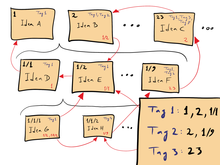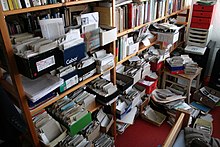Zettelkasten


The zettelkasten (German: "slip box", plural zettelkästen) is a method of note-taking and personal knowledge management used in research and study.
Method[]
A zettelkasten consists of many individual notes with ideas and other short pieces of information that are taken down as they occur or are acquired. The notes are numbered hierarchically, so that new notes may be inserted at the appropriate place, and contain metadata to allow the note-taker to associate notes with each other. For example, notes may contain tags that describe key aspects of the note, and they may reference other notes. The numbering, metadata, format and structure of the notes is subject to variation depending on the specific method employed.
A zettelkasten may be created and used in a digital format, sometimes using personal knowledge management software. But it can be and has long been done on paper using index cards.
The method not only allows a researcher to store and retrieve information related to their research, but also intends to enhance creativity[citation needed]. Cross-referencing notes through tags allows the researcher to perceive connections and relationships between individual items of information that may not be apparent in isolation[citation needed]. These emergent aspects of the method make the zettelkasten somewhat similar to a neural network[citation needed] with which one may "converse".[1]
History[]
In the form of paper index cards in boxes, the zettelkasten has long been used by individual researchers and by organizations to manage information, including the specialized form of the library catalog. Coming from a commonplace book tradition,[2] Conrad Gessner (1516–1565) invented his own method of organization in which the individual notes could be rearranged at any time.
The first early modern card index was designed by 17th-century English inventor Thomas Harrison (c. 1640s). Harrison's manuscript on The Ark of Studies[3] (Arca studiorum) describes a small cabinet that allows users to excerpt books and file their notes in a specific order by attaching pieces of paper to metal hooks labeled by subject headings.[4] Harrison's system was edited and improved by Vincent Placcius in his well-known handbook on excerpting methods (De arte excerpendi, 1689). Librarian and mathematician Gottfried Wilhelm Leibniz was known to have relied on Harrison’s invention in at least some of his research.
In 1767, Carl Linnaeus used "little paper slips of a standard size" to record information for his research.[5] Over 1,000 of Linnaeus's precursors to the modern index card containing information collected from books and other publications and measuring five by three inches are housed at the Linnean Society of London.[4]
Later in his own commonplace, under the heading "My way of collecting materials for future writings" (translated), Johann Jacob Moser (1701–1785) described the algorithms with which he filled his "card boxes".[6]
The 1794 idyll Leben des Quintus Fixlein by novelist Jean Paul is structured according to the zettelkasten in which the protagonist keeps his autobiography.[6] Jean Paul ultimately assembled 12,000 paper scraps into his commonplace books over the course of his lifetime, but died in 1825, almost a century before the advent of standardized note cards or box systems which later made it easier to store and organize them.[7]
Philosopher and intellectual historian Hans Blumenberg compiled more than 30,000 cards into his zettelkasten, which now occupy thirty-two conservation boxes at the German Literature Archive in Marbach. Blumenberg was inspired by the previous notetaking work and output of Georg Christoph Lichtenberg who used waste books or sudelbücher as he called them.[7]
One researcher famous for his extensive use of the method was the sociologist Niklas Luhmann (1927–1998). Luhmann built up a zettelkasten of some 90,000 index cards for his research, and credited it for enabling his extraordinarily prolific writing (including over 70 books and 400 scholarly articles).[8] He linked the cards together by assigning each a unique index number based on a branching hierarchy.[9] These index cards were digitized and made available online in 2019.[10] Luhmann described the zettelkasten as part of his research into systems theory in the essay "Kommunikation mit Zettelkästen".[11]
Other well known zettelkasten users include Arno Schmidt, Walter Kempowski, Friedrich Kittler, and Aby Warburg, whose works along with those of Paul, Blumenberg, and Luhmann appeared in the 2013 exhibition "Zettelkästen. Machines of Fantasy" at the Museum of Modern Literature, Marbach am Neckar.[12]
While not referred to specifically as zettelkasten by their non-German speaking users, there is a tradition of keeping similar notes in a commonplace book-like tradition in other countries. American comedians Phyllis Diller (with 52,000 3x5 inch index cards),[13][14] Joan Rivers (over a million 3x5 inch index cards),[15] Bob Hope (85,000 pages in files),[16] and George Carlin (paper notes in folders)[17] were known for keeping joke or gag files throughout their careers. They often compiled their notes from scraps of paper, receipts, laundry lists, and matchbooks which served the function of waste books. U.S. president Ronald Reagan kept punchlines for speeches in a card collection.[18]
See also[]
- Argument map
- Commonplace book
- Hypertext
- Issue-based information system
- Memex
- Notetaking
- Comparison of notetaking software
- Outliner
- Personal knowledge base
- Personal knowledge management
- Personal wiki
- List of wiki software § Personal wiki software
- Reference management software
- Tag (metadata) § Knowledge tags
References[]
- ^ Mittelmann, Angelika; Della Schiava, Manfred (2019). Wissensmanagement wird digital (in German). Norderstedt: Books on Demand. pp. 63–65. ISBN 9783746027654. OCLC 1111829173.
- ^ Havens, Earle (2001). Commonplace Books: A History of Manuscripts and Printed Books from Antiquity to the Twentieth Century. New Haven: Yale University. pp. 34–35.
- ^ Thomas Harrison, The Ark of Studies. Ed. by Alberto Cevolini. Turnhout: Brepols, 2017
- ^ Jump up to: a b Blei, Daniela (2017-12-01). "How the Index Card Cataloged the World". The Atlantic. The Atlantic. Archived from the original on 2021-07-04. Retrieved 4 July 2021.
- ^ Müller-Wille, Staffan; Charmantier, Isabelle (March 2012). "Natural history and information overload: The case of Linnaeus". Studies in History and Philosophy of Science Part C: Studies in History and Philosophy of Biological and Biomedical Sciences. 43 (1): Pages 4–15. doi:10.1016/j.shpsc.2011.10.021. PMC 3878424. Retrieved 2021-07-04.
- ^ Jump up to: a b Haarkötter, Hektor. "'Alles Wesentliche findet sich im Zettelkasten'". heise online (in German). Archived from the original on 2020-07-15. Retrieved 2020-05-31.
- ^ Jump up to: a b Helbig, Daniela K. "Ruminant machines: a twentieth-century episode in the material history of ideas". Journal of the History of Ideas Blog. Retrieved 8 June 2021.
- ^ Schmidt, Johannes. "Niklas Luhmann's Card Index: Thinking Tool, Communication Partner, Publication Machine" (PDF). In Cevolini, Alberto (ed.). Forgetting Machines: Knowledge Management Evolution in Early Modern Europe. Leiden; Boston: Brill. pp. 289–311. doi:10.1163/9789004325258_014. ISBN 9789004278462. OCLC 951955805. Archived (PDF) from the original on 2020-11-27. Retrieved 2020-09-04.
- ^ Beaudoin—Zapier, Jack (2 August 2020). "This simple but powerful analog method will rocket your productivity". Fast Company. Archived from the original on 17 November 2020. Retrieved 13 November 2020.
- ^ Noack, Pit. "Missing Link: Luhmanns Denkmaschine endlich im Netz". heise online (in German). Archived from the original on 2020-07-12. Retrieved 2020-05-31.
- ^ Luhmann, Niklas. "Kommunikation mit Zettelkästen. Ein Erfahrungsbericht", in: André Kieserling (ed.), Universität als Milieu. Kleine Schriften, Haux, Bielefeld 1992 (essay originally published 1981), ISBN 3-925471-13-8, p. 53–61; translated in: "Communicating with Slip Boxes". luhmann.surge.sh. Archived from the original on 2020-06-17. Retrieved 2020-05-31.
- ^ Gfrereis, Heike; Strittmatter, Ellen (2013). Zettelkästen. Maschinen der Phantasie. Germany: Deutsche Schillerges. ISBN 978-3-937384-83-2.
- ^ "Transcribing The Phyllis Diller Gag File". Smithsonian Institution. Retrieved 1 July 2021.
- ^ BredenbeckCorp, Hanna. "Help us transcribe Phyllis Diller's jokes—and enjoy some laughs along the way!". Natural Museum of National History. March 1, 2017. Retrieved 1 July 2021.
- ^ "The Joan Rivers Archives An exclusive look inside the lady's library-esque joke bank". GQ. Condé Nast Inc. Retrieved 1 July 2021.
- ^ "Bob Hope and American Variety: Joke File". Library of Congress. Retrieved 1 July 2021.
- ^ Rothman, Lily (2017-09-29). "Discover George Carlin's Foolproof System for Organizing Ideas". Time. Time Inc. Retrieved 1 July 2021.
- ^ Page, Susan (2011-05-08). "Ronald Reagan's note card collection being published". USA Today. Archived from the original on 2013-09-01. Retrieved 6 August 2021.
- Note-taking
- Knowledge management
- German words and phrases